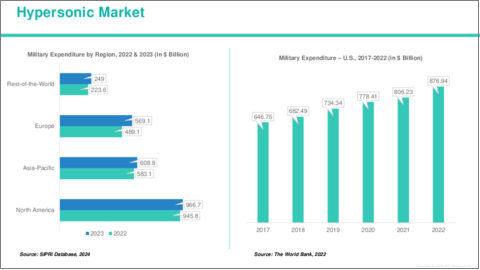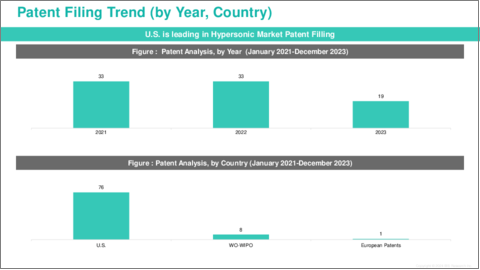|
|
市場調査レポート
商品コード
1518218
極超音速市場- 世界および地域別分析:タイプ別、発射モード別、エンドユーザー別、地域別 - 分析と予測(2024年~2034年)Hypersonic Market - A Global and Regional Analysis: Focus on Type, Launch Mode, End-user, and Region - Analysis and Forecast, 2024-2034 |
||||||
カスタマイズ可能
|
|||||||
| 極超音速市場- 世界および地域別分析:タイプ別、発射モード別、エンドユーザー別、地域別 - 分析と予測(2024年~2034年) |
|
出版日: 2024年07月23日
発行: BIS Research
ページ情報: 英文 100 Pages
納期: 1~5営業日
|
全表示
- 概要
- 目次
極超音速の市場規模は、地政学的緊張の激化、急速な技術進歩、世界の主要国間の軍事的優位性の追求を背景に、近年関心と投資が急増しています。
楽観的シナリオを考慮すると、2024年の市場規模は75億7,000万米ドルで、CAGR 8.94%で拡大し、2034年には178億2,000万米ドルに達すると予測されています。
| 主要市場統計 | |
|---|---|
| 予測期間 | 2024年~2034年 |
| 2024年の評価 | 75億7,000万米ドル |
| 2034年の予測 | 178億2,000万米ドル |
| CAGR | 8.94% |
Lockheed Martin Corporation、RTX、Northrop Grummanなどの大手防衛請負業者は、戦場で決定的な戦術的優位性を提供できる極超音速兵器とプラットフォームの開発への取り組みを強化しています。さらに、Hypersonix Launch Systems Ltd.やHERMEUS CORP.などの新興企業は、革新的な推進技術と斬新な設計コンセプトを活用して商業的極超音速移動の新境地を展開しており、より高速で効率的な世界的輸送手段を有望視しています。
極超音速市場における航空発射分野の優位性は、いくつかの重要な要因に起因しています。第一に、航空発射型極超音速システムは比類のない柔軟性と迅速な展開能力を提供し、進化する脅威とダイナミックな戦場シナリオへの迅速な対応を可能にします。さらに、航空発射セグメントは、航空宇宙技術の継続的な進歩と、主要な防衛請負業者および政府機関による極超音速研究開発プログラムの普及から利益を得ています。
当レポートでは、世界の極超音速市場について調査し、市場の概要とともに、シーケンシングタイプ別、製品別、用途別、エンドユーザー別、地域別の動向、および市場に参入する企業のプロファイルなどを提供しています。
目次
エグゼクティブサマリー
第1章 市場:業界の展望
- 動向:現在および将来の影響評価
- サプライチェーンの概要
- R&Dレビュー
- 規制状況
- ステークホルダー分析
- 主要な世界的イベントの影響分析
- 市場力学の概要
第2章 極超音速市場(用途別)
- 用途のセグメンテーション
- 用途の概要
- 極超音速市場(発射モード別)
- 極超音速市場(エンドユーザー別)
第3章 極超音速市場(製品別)
- 製品セグメンテーション
- 製品概要
- 極超音速市場(タイプ別)
第4章 極超音速市場(地域別)
- 極超音速市場(地域別)
- 北米
- 欧州
- アジア太平洋
- その他の地域
第5章 企業プロファイル
- 今後の見通し
- 地理的評価
- RTX
- BAE Systems
- L3Harris Technologies, Inc.
- Thales
- Reaction Engines
- Northrop Grumman
- Lockheed Martin Corporation
- Velontra
- Boeing
- AIRBUS
- HERMEUS CORP.
- Saab AB
- China Aerospace Science and Technology Corporation
- Hypersonix Launch Systems Ltd. MBDA
- その他
第6章 調査手法
Introduction to Hypersonic Market
The hypersonic market has witnessed a surge in interest and investment in recent years, driven by escalating geopolitical tensions, rapid technological advancements, and the quest for military superiority among major global powers. Considering the optimistic scenario the market is valued at $7.57 billion in 2024 and is expected to grow at a CAGR of 8.94% to reach $17.82 billion by 2034.
| KEY MARKET STATISTICS | |
|---|---|
| Forecast Period | 2024 - 2034 |
| 2024 Evaluation | $7.57 Billion |
| 2034 Forecast | $17.82 Billion |
| CAGR | 8.94% |
Leading defense contractors such as Lockheed Martin Corporation, RTX, and Northrop Grumman have intensified their efforts to develop hypersonic weapons and platforms capable of delivering decisive tactical advantages on the battlefield. Additionally, emerging players like Hypersonix Launch Systems Ltd. and HERMEUS CORP. are leveraging innovative propulsion technologies and novel design concepts to explore new frontiers in commercial hypersonic travel, promising faster, more efficient means of global transportation.
The dominance of the air launched segment in the hypersonic market can be attributed to several key factors. Firstly, air-launched hypersonic systems offer unparalleled flexibility and rapid deployment capabilities, allowing for swift response to evolving threats and dynamic battlefield scenarios. Moreover, the air launched segment benefits from ongoing advancements in aerospace technology and the proliferation of hypersonic research and development programs by leading defense contractors and government agencies. For instance, Lockheed Martin's development of the AGM-183A Air-launched Rapid Response Weapon (ARRW) exemplifies the growing emphasis on air-launched hypersonic capabilities, with the system designed to provide prompt, long-range strike capabilities against high-priority targets (""Air-Launched Hypersonic Weapon, AGM-183A ARRW""). These technological advancements, coupled with increasing investments in air-launched hypersonic systems by major military powers such as the United States, China, and Russia, further reinforce the market leadership of the Air Launched segment within the hypersonic market.
Based on the end-user, the market has been segmented into military, air force, navy and space. Based on type, the market has been segmented into hypersonic glide vehicle, hypersonic cruise missile, and hypersonic spaceplanes.
North America's leadership in the growth of the hypersonic market can be attributed to several factors, including substantial investments in research and development, a robust defense industrial base, and a strategic focus on hypersonic technology innovation. The region benefits from a strong network of government agencies, defense contractors, and research institutions collaborating on hypersonic projects, such as the Defense Advanced Research Projects Agency (DARPA) and partnerships between aerospace giants such as Lockheed Martin and Raytheon Technologies.
Additionally, North America's advanced manufacturing capabilities and technological expertise enable the rapid prototyping and deployment of hypersonic systems, positioning the region at the forefront of hypersonic research, development, and commercialization efforts.
Market Segmentation:
Segmentation 1: by Launch Mode
- Air Launched
- Surface Launched
- Subsea Launched
Segmentation 2: by End-user
- Military
- Air Force
- Navy
- Space
Segmentation 3: by Type
- Hypersonic Glide Vehicle
- Hypersonic Cruise Missile
- Hypersonic Spaceplanes
Segmentation 4: by Region
- North America
- Europe
- Asia-Pacific
- Rest-of-the-World
How can this report add value to an organization?
Product/Innovation Strategy: The global hypersonic market has been extensively segmented based on various categories, such as launch mode, end-user, and type. This can help readers get a clear overview of which segments account for the largest share and which ones are well-positioned to grow in the coming years.
Competitive Strategy: A detailed competitive benchmarking of the players operating in the global hypersonic market has been done to help the reader understand how players stack against each other, presenting a clear market landscape. Additionally, comprehensive competitive strategies such as partnerships, agreements, and collaborations will aid the reader in understanding the untapped revenue pockets in the market.
Key Market Players and Competition Synopsis
The companies that are profiled have been selected based on thorough secondary research, which includes analyzing company coverage, product portfolio, market penetration, and insights gathered from primary experts.
Some of the prominent names in this market are:
- RTX
- L3Harris Technologies, Inc.
- Thales
- Northrop Grumman
- Lockheed Martin Corporation
- Boeing
- China Aerospace Science and Technology Corporation
Key Questions Answered in this Report:
- What are the main factors driving the demand for hypersonic market?
- What are the major patents filed by the companies active in the hypersonic market?
- Who are the key players in the hypersonic market, and what are their respective market shares?
- What partnerships or collaborations are prominent among stakeholders in the hypersonic market?
- What are the strategies adopted by the key companies to gain a competitive edge in hypersonic market?
- What is the futuristic outlook for the hypersonic market in terms of growth potential?
- What is the current estimation of the hypersonic market and what growth trajectory is projected from 2024 to 2034?
- Which application, and product segment is expected to lead the market over the forecast period (2024-2034)?
- What could be the impact of growing application in the hypersonic market?
- Which regions demonstrate the highest adoption rates for hypersonic market, and what factors contribute to their leadership?
Table of Contents
Executive Summary
Scope and Definition
Market/Product Definition
Key Questions Answered
Analysis and Forecast Note
1. Markets: Industry Outlook
- 1.1 Trends: Current and Future Impact Assessment
- 1.2 Supply Chain Overview
- 1.2.1 Value Chain Analysis
- 1.2.2 Pricing Forecast
- 1.3 R&D Review
- 1.3.1 Patent Filing Trend by Year, by Country
- 1.4 Regulatory Landscape
- 1.5 Stakeholder Analysis
- 1.5.1 Use Case
- 1.5.2 End User and Buying Criteria
- 1.6 Impact Analysis for Key Global Events
- 1.7 Market Dynamics Overview
- 1.7.1 Market Drivers
- 1.7.2 Market Restraints
- 1.7.3 Market Opportunities
2. Hypersonic Market (by Application)
- 2.1 Application Segmentation
- 2.2 Application Summary
- 2.3 Hypersonic Market (by Launch Mode)
- 2.3.1 Air Launched
- 2.3.2 Surface Launched
- 2.3.3 Subsea Launched
- 2.4 Hypersonic Market (by End-user)
- 2.4.1 Military
- 2.4.2 Air Force
- 2.4.3 Navy
- 2.4.4 Space
3. Hypersonic Market (by Products)
- 3.1 Product Segmentation
- 3.2 Product Summary
- 3.3 Hypersonic Market (by Type)
- 3.3.1 Hypersonic Glide Vehicle
- 3.3.2 Hypersonic Cruise Missile
- 3.3.3 Hypersonic Spaceplanes
4. Hypersonic Market (by Region)
- 4.1 Hypersonic Market (by Region)
- 4.2 North America
- 4.2.1 Regional Overview
- 4.2.2 Driving Factors for Market Growth
- 4.2.3 Factors Challenging the Market
- 4.2.4 Application
- 4.2.5 Product
- 4.2.6 U.S.
- 4.2.6.1 Market by Application
- 4.2.6.2 Market by Product
- 4.2.7 Canada
- 4.2.7.1 Market by Application
- 4.2.7.2 Market by Product
- 4.2.8 Mexico
- 4.2.8.1 Market by Application
- 4.2.8.2 Market by Product
- 4.3 Europe
- 4.3.1 Regional Overview
- 4.3.2 Driving Factors for Market Growth
- 4.3.3 Factors Challenging the Market
- 4.3.4 Application
- 4.3.5 Product
- 4.3.6 Germany
- 4.3.6.1 Market by Application
- 4.3.6.2 Market by Product
- 4.3.7 France
- 4.3.7.1 Market by Application
- 4.3.7.2 Market by Product
- 4.3.8 U.K.
- 4.3.8.1 Market by Application
- 4.3.8.2 Market by Product
- 4.3.9 Italy
- 4.3.9.1 Market by Application
- 4.3.9.2 Market by Product
- 4.3.10 Rest-of-Europe
- 4.3.10.1 Market by Application
- 4.3.10.2 Market by Product
- 4.4 Asia-Pacific
- 4.4.1 Regional Overview
- 4.4.2 Driving Factors for Market Growth
- 4.4.3 Factors Challenging the Market
- 4.4.4 Application
- 4.4.5 Product
- 4.4.6 China
- 4.4.6.1 Market by Application
- 4.4.6.2 Market by Product
- 4.4.7 Japan
- 4.4.7.1 Market by Application
- 4.4.7.2 Market by Product
- 4.4.8 India
- 4.4.8.1 Market by Application
- 4.4.8.2 Market by Product
- 4.4.9 South Korea
- 4.4.9.1 Market by Application
- 4.4.9.2 Market by Product
- 4.4.10 Rest-of-Asia-Pacific
- 4.4.10.1 Market by Application
- 4.4.10.2 Market by Product
- 4.5 Rest-of-the-World
- 4.5.1 Regional Overview
- 4.5.2 Driving Factors for Market Growth
- 4.5.3 Factors Challenging the Market
- 4.5.4 Application
- 4.5.5 Product
- 4.5.6 South America
- 4.5.6.1 Market by Application
- 4.5.6.2 Market by Product
- 4.5.7 Middle East and Africa
- 4.5.7.1 Market by Application
- 4.5.7.2 Market by Product
5. Companies Profiled
- 5.1 Next Frontiers
- 5.2 Geographic Assessment
- 5.2.1 RTX
- 5.2.1.1 Overview
- 5.2.1.2 Top Products/Product Portfolio
- 5.2.1.3 Top Competitors
- 5.2.1.4 Target Customers
- 5.2.1.5 Key Personnel
- 5.2.1.6 Analyst View
- 5.2.1.7 Market Share
- 5.2.2 BAE Systems
- 5.2.2.1 Overview
- 5.2.2.2 Top Products/Product Portfolio
- 5.2.2.3 Top Competitors
- 5.2.2.4 Target Customers
- 5.2.2.5 Key Personnel
- 5.2.2.6 Analyst View
- 5.2.2.7 Market Share
- 5.2.3 L3Harris Technologies, Inc.
- 5.2.3.1 Overview
- 5.2.3.2 Top Products/Product Portfolio
- 5.2.3.3 Top Competitors
- 5.2.3.4 Target Customers
- 5.2.3.5 Key Personnel
- 5.2.3.6 Analyst View
- 5.2.3.7 Market Share
- 5.2.4 Thales
- 5.2.4.1 Overview
- 5.2.4.2 Top Products/Product Portfolio
- 5.2.4.3 Top Competitors
- 5.2.4.4 Target Customers
- 5.2.4.5 Key Personnel
- 5.2.4.6 Analyst View
- 5.2.4.7 Market Share
- 5.2.5 Reaction Engines
- 5.2.5.1 Overview
- 5.2.5.2 Top Products/Product Portfolio
- 5.2.5.3 Top Competitors
- 5.2.5.4 Target Customers
- 5.2.5.5 Key Personnel
- 5.2.5.6 Analyst View
- 5.2.5.7 Market Share
- 5.2.6 Northrop Grumman
- 5.2.6.1 Overview
- 5.2.6.2 Top Products/Product Portfolio
- 5.2.6.3 Top Competitors
- 5.2.6.4 Target Customers
- 5.2.6.5 Key Personnel
- 5.2.6.6 Analyst View
- 5.2.6.7 Market Share
- 5.2.7 Lockheed Martin Corporation
- 5.2.7.1 Overview
- 5.2.7.2 Top Products/Product Portfolio
- 5.2.7.3 Top Competitors
- 5.2.7.4 Target Customers
- 5.2.7.5 Key Personnel
- 5.2.7.6 Analyst View
- 5.2.7.7 Market Share
- 5.2.8 Velontra
- 5.2.8.1 Overview
- 5.2.8.2 Top Products/Product Portfolio
- 5.2.8.3 Top Competitors
- 5.2.8.4 Target Customers
- 5.2.8.5 Key Personnel
- 5.2.8.6 Analyst View
- 5.2.8.7 Market Share
- 5.2.9 Boeing
- 5.2.9.1 Overview
- 5.2.9.2 Top Products/Product Portfolio
- 5.2.9.3 Top Competitors
- 5.2.9.4 Target Customers
- 5.2.9.5 Key Personnel
- 5.2.9.6 Analyst View
- 5.2.9.7 Market Share
- 5.2.10 AIRBUS
- 5.2.10.1 Overview
- 5.2.10.2 Top Products/Product Portfolio
- 5.2.10.3 Top Competitors
- 5.2.10.4 Target Customers
- 5.2.10.5 Key Personnel
- 5.2.10.6 Analyst View
- 5.2.10.7 Market Share
- 5.2.11 HERMEUS CORP.
- 5.2.11.1 Overview
- 5.2.11.2 Top Products/Product Portfolio
- 5.2.11.3 Top Competitors
- 5.2.11.4 Target Customers
- 5.2.11.5 Key Personnel
- 5.2.11.6 Analyst View
- 5.2.11.7 Market Share
- 5.2.12 Saab AB
- 5.2.12.1 Overview
- 5.2.12.2 Top Products/Product Portfolio
- 5.2.12.3 Top Competitors
- 5.2.12.4 Target Customers
- 5.2.12.5 Key Personnel
- 5.2.12.6 Analyst View
- 5.2.12.7 Market Share
- 5.2.13 China Aerospace Science and Technology Corporation
- 5.2.13.1 Overview
- 5.2.13.2 Top Products/Product Portfolio
- 5.2.13.3 Top Competitors
- 5.2.13.4 Target Customers
- 5.2.13.5 Key Personnel
- 5.2.13.6 Analyst View
- 5.2.13.7 Market Share
- 5.2.14 Hypersonix Launch Systems Ltd.
- 5.2.14.1 Overview
- 5.2.14.2 Top Products/Product Portfolio
- 5.2.14.3 Top Competitors
- 5.2.14.4 Target Customers
- 5.2.14.5 Key Personnel
- 5.2.14.6 Analyst View
- 5.2.14.7 Market Share
- 5.2.15 MBDA
- 5.2.15.1 Overview
- 5.2.15.2 Top Products/Product Portfolio
- 5.2.15.3 Top Competitors
- 5.2.15.4 Target Customers
- 5.2.15.5 Key Personnel
- 5.2.15.6 Analyst View
- 5.2.15.7 Market Share
- 5.2.16 Other Key Players
- 5.2.1 RTX






